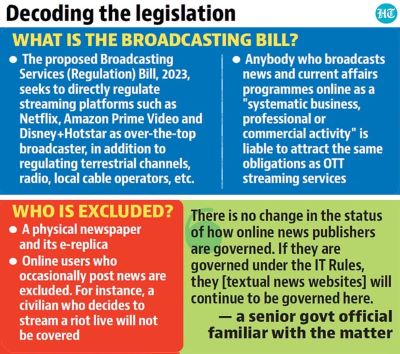Context:
Could Dhruv Rathee and Ravish Kumar’s YouTube videos have influenced voter preferences in the 2024 general election? This question concerns a Union government that asserted that it would return to power with an increased majority but was voted back as a coalition with a diminished mandate. Recognising a threat to its power, it aims to neuter digital creators under the Broadcasting Regulation Bill, 2024.
The Growing Influence of Digital Media
Data Insights
Two CSDS (Centre for the Study of Developing Societies)-Lokniti surveys reveal significant data on digital media consumption:
● 642 million voters and 924 million broadband connections.
● 29% of respondents consume political content daily on digital platforms, surpassing newspapers and radio but still less than television.
● Popular platforms include WhatsApp (35.1%), YouTube (32.3%), Facebook (24.7%), Instagram (18.4%), and Twitter (6.5%).
Impact on Elections
This data indicates a "content election" or "influencer election," where digital media critical of the Prime Minister challenges traditional television news dominance. Vanita Kohli-Khandekar notes that television news caters mainly to BJP voters and is homogenized, making digital media a crucial platform for alternative narratives.
Government’s Strategy for Control
Early Measures
The Information Technology (IT) Rules, 2021 marked the beginning of increased government control over digital content. These rules expanded the Ministry of Electronics and Information Technology’s (MeitY) powers and introduced traceability mandates, affecting end-to-end encryption on messaging services. The Ministry of Information and Broadcasting (MIB) gained new powers to register and block digital news media and online streaming apps, with enforcement aligning with nationalistic themes.
Further Expansion
Despite initial efforts under the IT Rules, 2021, the government sought greater control:
● Three “Grievance Appellate Committee(s)” (GACs) were created on January 28, 2023 to handle appeals and issue orders on digital content.
● On April 6, 2023 IT Rules were amended to allow the removal of "fake, false, and misleading" content, though this amendment was stayed by the Supreme Court on March 21, 2024.

The Broadcasting Services (Regulation) Bill, 2024
The Broadcasting Services (Regulation) Bill, 2024 represents a significant escalation in digital censorship. The Bill was first introduced as the Broadcasting Services (Regulation) Bill, 2023, but has since been revised. It reflects the government's efforts to control online narratives further.
Key Features
● Expanded Scope: The Draft Broadcasting Regulation Bill, 2023 extends its regulatory reach by defining individual commentators as “Digital News Broadcasters” and content creators as “OTT Broadcasters.” The Ministry of Information and Broadcasting (MIB) can set subscriber thresholds for registration, broadening its oversight to various digital media actors.
● New Compliance Requirements: The Bill imposes additional compliance measures on online platforms, including mandatory registration and adherence to new censorship guidelines. It introduces a separate safe harbour regime from the Information Technology Act, 2000, establishing new standards for content management.
● Censorship and Enforcement: The Bill enhances censorship and enforcement by requiring proactive compliance, including registration and self-censorship by platforms. The MIB gains broad discretion to enforce censorship and impose fines, with potentially vague and arbitrary provisions leading to inconsistent enforcement.
● Contemporary Definitions and Future-Ready Provisions: To address technological advancements, the Bill updates definitions for modern broadcasting and includes provisions for emerging technologies, ensuring the legislation remains relevant and adaptable.
● Enhanced Self-Regulation: The Bill improves self-regulation by creating ‘Content Evaluation Committees’ and transforming the Inter-Departmental Committee into a broader ‘Broadcast Advisory Council,’ promoting greater industry participation and oversight.
● Statutory Penalties and Fines: It introduces a range of statutory penalties, such as advisories, warnings, and monetary fines, while retaining severe penalties for serious offences. The focus is on balancing regulation with fairness.
● Infrastructure Sharing, Platform Services, and Right of Way: The Bill promotes infrastructure sharing among broadcasters and addresses platform services. It streamlines Right of Way management and includes a structured dispute resolution mechanism for infrastructure-related conflicts.
Implications of the Bill
● Increased Control: The Bill creates a "digital licence raj," characterized by bureaucratic and politicized control over digital media. It aims to replace the notice-and-takedown approach with a comprehensive system of preemptive censorship and compliance.
● Digital Authoritarianism: Critics argue that the Bill will reduce transparency, increase government powers, and erode fundamental rights. The system is seen as a move toward digital authoritarianism, with the government seeking to control online narratives through a labyrinth of regulations.
● Oligopolistic Media Ownership Tendencies: The Bill may inadvertently promote oligopolistic tendencies in media ownership, as government and media house alignments could favor a concentration of media power, potentially stifling diverse and independent voices.
● Potential Impact on Minority Communities: There are fears that the Bill might lead to the marginalization or misrepresentation of Indian minority communities. The ambiguous language in the draft could be exploited to promote a homogenized majority identity, potentially sidelining diverse perspectives.
● Ambiguous Provisions in the Draft: The Bill contains provisions with broad and vague language, such as those granting authorities the power to prohibit content. This raises concerns about the role of "authorized officers" and their potential influence under government direction.
Conclusion
The Broadcasting Services (Regulation) Bill, 2024 represents a significant shift in the regulation of digital content in India. It reflects the government's desire to control online narratives and manage digital media more tightly. The Bill’s provisions highlight a move towards increased censorship and regulation, raising concerns about freedom of expression and the future of digital content creation in India.
To ensure effective broadcasting regulation in India, a comprehensive legislative framework is essential, covering traditional TV, OTT (Over-The-Top) platforms, and digital media. Encouraging competition, consulting stakeholders, and adapting to technological advancements will enhance content diversity and relevance. Establishing an independent regulatory body, implementing clear enforcement mechanisms, and promoting media literacy are crucial. Regular updates and incorporating international best practices will help maintain a balanced, democratic media environment. By integrating these steps, India can develop a robust and adaptive broadcasting regulatory framework that balances innovation with regulation, supports diverse media voices, and fosters a democratic media landscape.
|
Probable Questions for UPSC Mains 1. Discuss the implications of the Broadcasting Services (Regulation) Bill, 2024 on digital media freedom and content creation in India. What measures can be taken to ensure that the Bill does not undermine democratic values and diversity in the media? (10 Marks, 150 Words) 2. Evaluate the impact of the Broadcasting Services (Regulation) Bill, 2024 in the context of India's media landscape and electoral politics. Discuss the potential risks of increased government control over digital media and propose strategies to mitigate these risks while promoting a vibrant and democratic media environment. (15 Marks, 250 Words) |
Source: The Hindu









